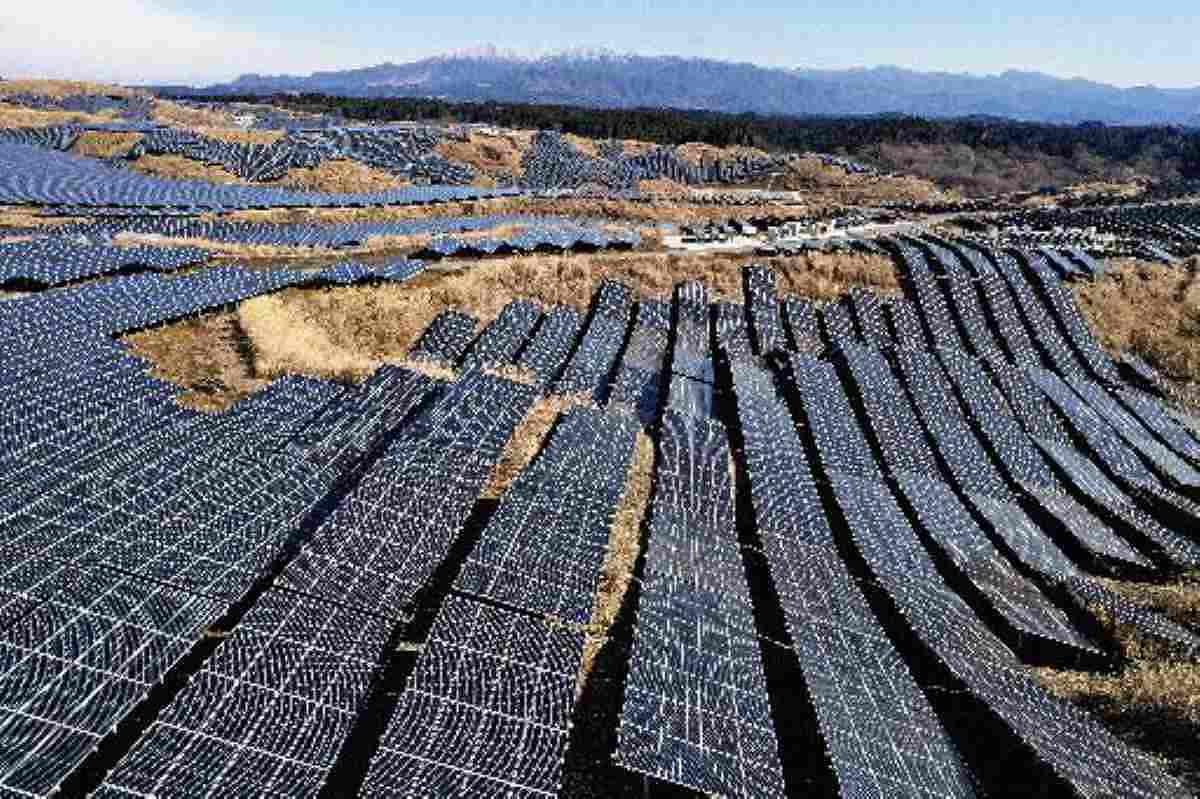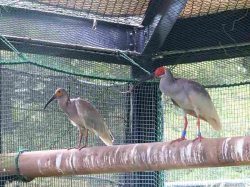Solar Panels Around Southern Japan’s Mt. Aso Stoke Fears Over Landscape; Local Govt Scrambles to Preserve Nature

Solar panels cover a field in Yamato, Kumamoto Prefecture, in December last year.
1:00 JST, April 5, 2024
The increase of solar power plants in areas on and around Mt. Aso in Kumamoto Prefecture has stoked fears that the accompanying solar panels may spoil the beauty of the area, which includes one of the world’s largest calderas and Aso-Kuju National Park.
Other national parks across the nation are seeing a similar increase in solar panels, which has prompted the Environment Ministry to consider measures to avoid negative impacts to the areas’ scenery. The ministry plans to expand the borders of Aso-Kuju National Park and tighten the park’s regulations by the end of this fiscal year.
Kyushu’s largest
A sea of glistening black solar panels covers fields in Yamato, a town in the south of the Aso area. They belong to a power plant run by a major Tokyo-based renewable energy company.
The solar panels, which spill into neighboring Takamori, span 191 hectares — about 27 times larger than Fukuoka PayPay Dome baseball stadium — producing a power output that is among the highest in Kyushu.
Cattle used to graze the fields, which were jointly owned by 26 members of Fuyuno Bokuya Kumiai, a livestock farming union that local residents established.
Masaru Morita, 70, former head of the union, said, “When about 10 years ago we discontinued the controlled burns which are necessary for maintaining the fields, they deteriorated. The only thing left to do was sell.”
The union was worried about the age of the members and a shortage of successors. When they put the land up for sale, over 10 solar power companies made inquiries.
The grazing cattle then disappeared from the land and were replaced by solar panels. Locals voiced concerns, saying, “It looks strange. I’m worried [the solar panels] might have spoiled the beauty of the Aso area.”
But Morita insisted: “We don’t regret selling. It was a decision we all made together after much discussion. If others want to say, ‘The fields should be protected,’ then the current system, which puts all the burden of maintaining and managing the fields on our union, has to change.”
The company operating the solar power plant said that it has taken measures to preserve the natural environment, including by designating forest zones around the plant and using colors that match the surrounding scenery for utility poles. “We’ve put on town hall-style meetings and had the locals come in to inspect the business, increasing their understanding of the business while we carry out operations,” an official of the company said.
Special zones
According to the Kumamoto prefectural government, there were more than 20 solar power plants, each with an output of one megawatt or larger in the Aso area as of the end of November last year. Six of them are in Yamato.
Kumamoto prefecture has boasted a unique landscape shaped by 22,000 hectares of bokuya — grass fields where cattle are kept in open air. But the prefectural government does not know exactly how many solar power facilities have been built on the fields. The number of lost acres of bokuya fields is therefore unknown.
The Natural Parks Law can restrict land development inside the 73,000 hectares of Aso-Kuju National Park, which stretches through Kumamoto and Oita prefectures.
Nevertheless, companies that fulfill certain criteria can obtain permission from the prefectural government to develop forest areas outside the national park’s boundaries and build solar power plants there.
The Environment Ministry is considering expanding the size of the national park and increasing “special zones” where strict regulations make it impossible to develop solar power plants.
An official at the office that manages the national park in Aso said, “We want speed up the implementation of these measures.”
World Heritage worries
The prefectural government, which is aiming to get the Aso area registered as a World Heritage site, is also working to address this issue.
Together with seven nearby municipalities, it set up a council which in 2020 adopted a declaration that stipulates solar power facilities must not seriously detract from an area’s natural beauty.
The council also compiled guidelines which stipulate that solar power plants “in principle should not be built on grass fields.” But the guidelines are not legally binding, and the member municipalities hold deep concerns about whether these actions will be effective.
In September 2023, the prefectural government established new criteria related to attracting solar power generation facilities and designated central Aso as a zone excluded from development.
The municipal governments will also be able to designate areas for solar power projects.
The prefectural government said that residents are increasingly concerned about negative effects on the natural environment and scenery, and it published a map which indicates potentially affected areas.
An official in the prefectural government’s energy policy section said: “What’s important is balancing environmental preservation with renewable energy development. It’s necessary to be able to allocate particular development projects to suitable places.”
Nationwide plans
Propelled by an upwards trend in both the encouragement and development of renewable energy resources, an increasing number of large-scale solar power plants have appeared in national parks throughout Japan, including in Kushiro Marshland in Hokkaido and Ise-Shima National Park in Mie Prefecture.
Locals in those areas likewise voice fears that the solar power structures may adversely affect the natural environment, which is home to rare animals and plants.
According to the Environment Ministry, 26 solar power plants were located within national parks across the nation as of late February 2014. Six of them were mega solar power plants with one megawatt or larger output capacity.
At the end of March 2023, that former increased five-fold to 129, and the latter rose to nine.
Six of the nine mega solar plants are concentrated in Aso-Kuju National Park. Because the national park includes vast amounts of privately-owned land — both residential and farming — restricting development uniformly is difficult.
The ministry has taken measures to cope with the issues as they arise, such as by implementing new guidelines that stipulate criteria for granting development permission.
An official at the ministry’s National Park Division said: “Understanding among locals is essential for expanding the development of renewable energy developments. We also want to team up with municipal governments to protect natural environments and sceneries.”
"Science & Nature" POPULAR ARTICLE
-

Genome Study Reveals Milestone in History of Cat Domestication
-

Big Leap in Quest to Get to Bottom of Climate Ice Mystery
-

Japan Set to Participate in EU’s R&D Framework, Aims to Boost Cooperation in Tech, Energy
-

Paws on Parade: Nairobi’s Dogs Dazzle at ‘Pawchella’
-

Japan’s H3 Rocket Failed in Latest Launch, Says Official
JN ACCESS RANKING
-

Tokyo Economic Security Forum to Hold Inaugural Meeting Amid Tense Global Environment
-

Keidanren Chairman Yoshinobu Tsutsui Visits Kashiwazaki-Kariwa Nuclear Power Plant; Inspects New Emergency Safety System
-

Imports of Rare Earths from China Facing Delays, May Be Caused by Deterioration of Japan-China Relations
-

University of Tokyo Professor Discusses Japanese Economic Security in Interview Ahead of Forum
-

Japan Pulls out of Vietnam Nuclear Project, Complicating Hanoi’s Power Plans
























